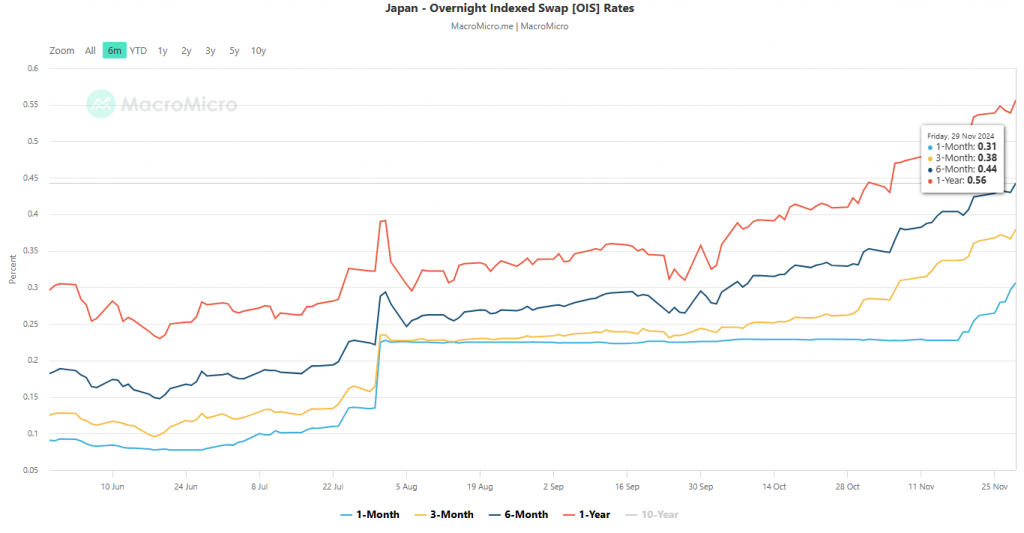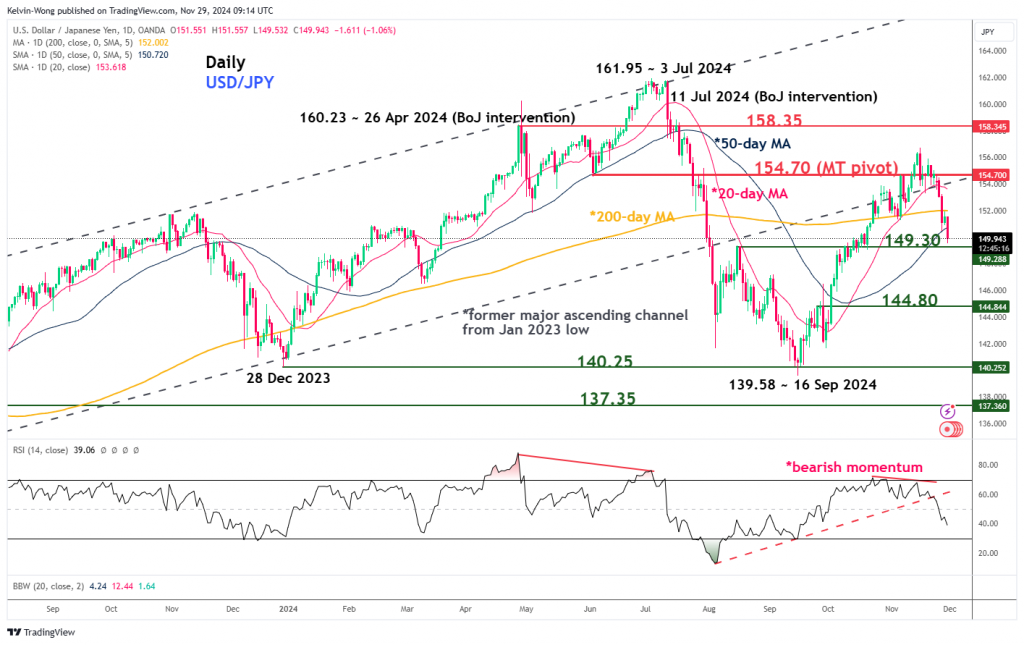- Yen strength continued to persist reinforced by an uptick seen in the leading Tokyo’s core-core inflation rate as it rose to 1.9% y/y in November.
- Japan’s overnight swap rates have indicated an increase in odds that BoJ may hike its short-term policy interest rate again in the upcoming 18-19 December meeting.
- Watch the 149.30 intermediate support (potential downside trigger) on the USD/JPY.
Earlier this week, we published two reports that highlighted the potential looming yen strength against other major currencies such as the AUD/JPY and CAD/JPY, click here and here for a recap.
One of the supporting factors for the likely looming medium-term yen strength revival may be due to increasing demand for safe-haven currency macro theme play bets being structured in the FX market via the yen as more potential tariff threats may be drummed out by the incoming Trump administration.
Today, it is the USD/JPY turn to show yen strength as it tumbled to breach below the 150.00 psychology level and hit a six-week low of 149.80 at this time of the writing.
The primary fundamental factor that triggered the renewed weakness in the USD/JPY has been an uptick in the Tokyo inflation data for November as it is considered a leading indicator of Japan’s nationwide inflation price trends.
Tokyo’s inflationary trend has started to reverse up
Fig 1: Japan’s PPI, core-core CPI & Tokyo core-core CPI trends as of Nov 2024 (Source: TradingView, click to enlarge chart)
The Tokyo core-core inflation rate that stripped out food and energy components, a better gauge of demand-side inflation rose steadily for the second consecutive month to 1.9% y/y in November from a 1.8% increase in October (see Fig 1).
Also, its subcomponent services-sector prices in Tokyo rose 0.9% in November from a year earlier after a gain of 0.8% in October.
This latest set of inflationary data from Tokyo suggests a potential sign of broadening price pressure, and sustained wage gains that allowed firms to charge more for services, in turn increasing confidence that Japan is on the path of making steady progress to stay above Bank of Japan (BoJ)’s 2% inflation target. The last reading of the nationwide Japan core-core inflation rate (excluding fresh food and energy) rose to 2.3% y/y in October from 2.1% in September.
BoJ’s monetary policy meeting in December is now “live”
Fig 2: Japan overnight indexed swap rates medium-term trends as of 29 Nov 2024 (Source: MacroMicro, click to enlarge chart)
The BoJ ended its negative interest rates in March after eight years and raised its short-term policy interest rate by 15 basis points (bps) to 0.25% in July.
After the release of the latest upbeat Tokyo’s inflationary trends, market participants have now increased bets that BoJ may introduce another interest rate hike after its 18-19 December monetary policy as part of BoJ’s gradual normalization policy framework after it ended its decade-plus of ultra-accommodative monetary policy in March this year.
The spread of the 3-month and 6-month Japan overnight indexed swap rates have widened significantly since Tuesday, 19 November over the 1-month swap rate. Both the 3-month and 6-month swap rates rose to 0.38% and 0.44% respectively, above the 1-month swap rate at 0.31% as of Friday, 29 November (see Fig 2).
The widening of the 3-month and 6-month Japan overnight indexed swap rates over its 1-month counterpart is likely to put a ceiling on further US dollar strength against the yen at least in the short to medium term.
USD/JPY broke below its 50-day moving average with bearish momentum
Fig 3: USD/JPY medium-term & major trend phases as of 29 Nov 2024 (Source: TradingView, click to enlarge chart)
The price actions of the USD/JPY have sliced below its 50-day moving average today and recorded an accumulated intraday loss of 4.25% since its 15 November 2024 high of 156.75.
In addition, its daily RSI momentum indicator has staged a breakdown below a significant parallel ascending trendline support after it flashed out an earlier bearish divergence condition at the overbought region on 14 November (see Fig 3).
A break below the 149.30 intermediate support may trigger the start of a potential medium-term (multi-week) corrective decline sequence on the USD/JPY to expose the next medium-term supports at 144.80 and 140.25 in the first step.
On the other hand, a reintegration above the 154.70 key medium-term pivotal resistance invalidates the bearish scenario for the next medium-term resistance to come in at 158.35.
Content is for general information purposes only. It is not investment advice or a solution to buy or sell securities. Opinions are the authors; not necessarily that of OANDA Business Information & Services, Inc. or any of its affiliates, subsidiaries, officers or directors. If you would like to reproduce or redistribute any of the content found on MarketPulse, an award winning forex, commodities and global indices analysis and news site service produced by OANDA Business Information & Services, Inc., please access the RSS feed or contact us at info@marketpulse.com. Visit https://www.marketpulse.com/ to find out more about the beat of the global markets. © 2023 OANDA Business Information & Services Inc.





